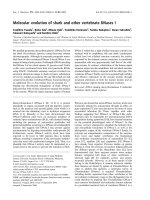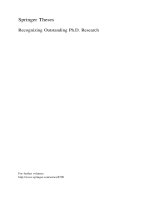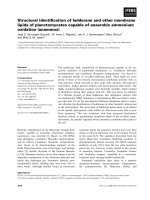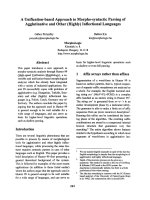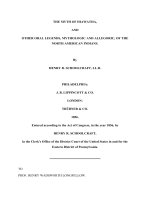Tables of integrals and other math data 3rd ed h dwight
Bạn đang xem bản rút gọn của tài liệu. Xem và tải ngay bản đầy đủ của tài liệu tại đây (11.42 MB, 198 trang )
A Series of Mathematical
For Colleges
Texts
Edited by
EARLE RAYMOND HEDRICK
TABLES
AND
OT,HER
OF
INTEGRALS
MATHEMATICAL
DATA
THE
MACMILLAN
COMPANY
NEW YORK . CHICAGO
dTI,ANTh . BAN FRANCISCO
LONDON . M*NILA
DALLAS.
BRETT-MACMILLAN
TORONTO
f
i
i
LTD.
TABLES OF INTEGRALS AND
OTHER MATHEMATICAL DATA
HERBERT
BRISTOL
DWIGHT,
D.Sc.
Professor of Electrical Machinery
Massachusetts Insta’tute of Technology
THIRD
EDITION
.New York
THE
MACMILLAN
COMPANY
Third
Edition
@ The Macmillan
Company
All rights reserved-no
part of this book may
form without permission in writing from the
reviewer who wishes to quote brief passages
review written for inclusion in magazine
Printed
in the United
1957
be reproduced in any
publisher, except by a
in connection with a
or newspaper.
States of America
Firsl Printing
Previous editions copyright, 1934, 1947,
by The Marmillan
Company
Library
of Congress catalog card number: 57-7909
.~
PREFACE
TO THE
FIRST
EDITION
The first study of any portion of mathematics should not be
done from a synopsis of compact results, such as this collection.
The references, although they are far from complete, will be
helpful, it is hoped, in showing where the derivation of the results
is given or where further similar results may be found.
A list
of numbered references is given at the end of the book. These
are referred to in the text as “Ref. 7, p. 32,” etc., the page number being that of the publication to which reference is made.
Letters are considered to represent real quantities unless otherwise stated.
Where the square root of a quantity is indicated,
the positive value is to be taken, unless otherwise indicated.
Two vertical lines enclosing a quantity represent the absolute or
numerical value of that quantity, that is, the modulus of the
quantity.
The absolute value is a positive quantity.
Thus,
log I- 31 = log 3.
The constant of integration is to be understood after each
integral.
The integrals may usually be checked by differentiating.
In algebraic expressions, the symbol log represents natural
or Napierian logarithms, that is, logarithms to the base e. When
any other base is intended, it will be indicated in the usual
manner.
When an integral contains the logarithm of a certain
quantity, integration should not be carried from a negative to a
positive value of that quantity.
If the quantity is negative, the
logarithm of the absolute value of the quantity may be used,
since log (- 1) = (2k + 1) ?ri will be part of the constant of
integration
(see 409.03). Accordingly, in many cases, the logarithm of an absolute value is shown, in giving an integral, so as
to indicate that it applies to real values, both positive and
negative.
Inverse trigonometric functions are to be understood as referring to the principal values.
Suggestions and criticisms as to the material of this book and
as to errors that may be in it, will be welcomed.
v
vi
PREFACE
The author desires to acknowledge valuable suggestions from
Professors P. Franklin, W. H. Timbie, L. F. Woodruff, and
F. S. Woods, of Massachusetts Institute of Technology.
H. B. DWIGHT.
CAMBRIDGE, MASS.
December, 1933.
PREFACE
TO THE
SECOND
EDITION
A considerable number of items have been added, including
groups of integrals involving
(ax2
+
62~
+
fP2,
r+kx
and
a
+
l
cos
2
)
also additional material on inverse functions of complex quantiA probability integral table (No.
ties and on Bessel functions.
1045) has been included.
It is desired to express appreciation for valuable suggestions
from Professor Wm. R. Smythe of California Institute of Technology and for the continued help and interest of Professor Philip
Franklin of the Department of Mathematics, Massachusetts Institute of Technology.
HERBERT B. DWIGHT.
CAMBRIDGE, MASS.
PREFACE
TO THE
THIRD
EDITION
In this edition, items 59.1 and 59.2 on determinants have been
added. The group (No. 512) of derivatives of inverse trigoOn page 271
nometric functions has been made more complete.
material is given, suggested by Dr. Rose M. Ring, which extends
the tables of ez and e-z considerably, and is convenient when a
calculating machine is used.
Tables 1015 and 1016 of trigonometric functions of hundredths
of degrees are given in this edition on pages 220 to 257. When
calculating machines are used, the angles of a problem are
PREFACE
vii
usually given in decimals. A great many trigonometric formulas
involve addition of angles or multiplication
of them by some
quantity, and even when the angles are given in degrees, minutes,
and seconds, to change the values to decimals of a degree gives
the advantages that are always afforded by a decimal system
compared with older and more awkward units.
In such cases,
the tables in hundredths of degrees are advantageous.
HERBERT B. DWIGHT
LEXINGTON, MASS.
38
RATIONAL
ALGEBRAIC
Integrals
170.
Involving
dX
s a4 + x4
FUNCTIONS
Crrf x4
x2 + ax42 + a2
x2 - ax42 + a2
1
+
170.1.
x dx
=
s a4 + x4
170.2.
x2dx
-a4 + x4 = - &kx2
s
x3dx
= a log (a” + x4),
s a4 + x4
171.3.
s
173.
x3dx
= - alog Ia4 - x41.
a4 - x4
dx
= -&og
s x(a + bxm)
ax42
tJan-l
-0
a2 _
tan-’
-.
($2 -
x2 + ax42 + a2
- ax42 + a2
1
+
170.3.
275&j$j
Zm
.
I a + bxm I
-2
x2
ax42
x2
CONTENTS
P&m
ITEMwo.
1. ALGEBRAIC
...............................
FUNCTIONS.
1
.....................
60. Algebraic Functions-Derivatives.
...............
80. Rational Algebraic Functions-Integrals.
...............
180. Irrational
Algebraic Functions-Integrals.
400.
TRIGONOMETRIC
427. Trigonometric
429. Trigonometric
FUNCTIONS.
14
16
39
73
87
87
...........................
Functions-Derivatives.
Functions-Integrals.
.................
...................
500. INVERSE TRIGONOMETRIC FUNCTIONS. ...................
..........
512. Inverse Trigonometric
Functions-Derivatives.
............
515. Inverse Trigonometric
Functions-Integrals.
112
115
116
FUNCTIONS. .............................
550. EXPONENTIAL
...................
563. Exponential
Functions-Derivatives.
.....................
565. Exponential
Functions-Integrals.
125
126
126
585. PROBABILITY
129
INTEGRALS.
..............................
600. LOGARITHMIC FUNCTIONS. .............................
.....................
610. Logarithmic
Functions-Integrals.
130
133
650. HYPERBOLIC FUNCTIONS. ..............................
....................
667. Hyperbolic
Functions-Derivatives.
......................
670. Hyperbolic
Functions-Integrals.
143
146
147
700. INVERSE HYPERBOLIC FUNCTIONS. ......................
.............
728. Inverse Hyperbolic
Functions-Derivatives.
...............
730. Inverse Hyperbolic
Functions-Integrals.
156
160
160
. 168
750. ELLIPTIC FUNCTIONS. .........................
...............
768. Elliptic Functions-Derivatives.
.................
770. Elliptic Functions-Integrals.
. . . . . . 170
. . . . . . 170
800. BESSEL FUNCTIONS. ..........................
...................
835. Bessel Functions-Integrals.
. . . . . . 174
. . . . . . 191
840. SURFACE ZONAL HARMONICS.
850. DEFINITE
INTEGRALS.
890. DIFFERENTIAL
..................
........................
EQUATIONS.
............................
ix
. 192
. . . . . . 194
204
CONTENTS
APPENDIX
A. TABLES OF NUMERICAL
VALUES ............................
PAGE
209
TABLE
1000.
1005.
1010.
1011.
1012.
1015.
1016.
Values of du2 + b2/a .............................
Gamma Function .................................
Trigonometric Functions (Degrees and Minutes). ....
Degrees, Minutes, and Seconds to Radians. .........
Radians to Degrees, Minutes, and Seconds...........
Trigonometric Functions: Sin and Cos of Hundredths
of Degrees.......................................
Trigonometric Functions: Tan and Cot of Hundredths
of Degrees.......................................
Logarithms to Base 10. ...........................
Natural Logarithms ...............................
Exponential and Hyperbolic Functions ..............
Complete Elliptic Integrals of the First Kind. .......
Complete Elliptic Integrals of the Second Kind. .....
Normal Probability Integral. ......................
Bessel Functions. .................................
Some Numerical Constants. .......................
Greek Alphabet ..................................
210
212
213
218
219
220
B. REFERENCES .............................................
238
258
260
264
272
274
275
276
283
283
284
INDEX.....................................................
287
1020.
1025.
1030.
1040.
1041.
1045.
1050.
1060.
1070.
TABLES
AND
OTHER
OF INTEGRALS
MATHEMATICAL
DATA
.
TABLES OF INTEGRALS AND OTHER
MATHEMATICAL DATA
ALGEBRAIC
FUNCTIONS
+ n(n - l)(n - 2) ti
31
nl
+ . . . + (n - qrtX'
+ -***
(1 + a$” = 1 + nx +@2, - llx2
I.
Note that, here and elsewhere, we take O! = 1. If n is a positive integer,
If n is not a positive
the expression consists of a finite number of terms.
integer, the series is convergent for 1” < 1; and if n > 0, the series is conmef. 21, p. 88.1
vergent also for x2 = 1.
2.
The coefficient
of z+ in No. 1 is denoted by
Values are given in the following
TABLE
OF
i
4
:1
:
2
BINOMIAL
COEFFICIENTS
2
5
10
:
;fl
1
values of T in top row
5
“i’p-pq
+p+p
N.B.
N.B.
Sum
Sum of any
any two
two adjanumbers
numbers
in ame
same row
row is
is
equal to number just below
the right-hand one of them.
ii
x
7t
4
3
10
or ,C,.
table.
,C;: Values of n in left column;
oll
1
===,=r=zwm=----===,=Yzzzwm=-----
:
0
i
6
cent
1
::
20
1;:
i
21
ii
56
35
l%i
tz
126
:A
ii::
t3
1%
2io
252
210
13260
45
t
1
4:
1:
1
For a large table see Ref. 59, v. 1, second section, p. 69.
3.
n(n -- 1)
n(n - l)(n
(1 - x)* = 1 - nx + -2r
x2 3!
+ . . . + (-- l)r(n f&!”
- 2) ~
+ -**-
[See Table 2 and note under No. 1.1
4.
(a&x)“=al(l*gn.
1
2
ALGEBRAIC
FUNCTIONS
4.2.
(1 f z)~ = 1 f 2x + x2.
4.3.
(1 f x)3 = 1 f 3x + 3x2 f 2.
4.4.
(1 f x)” = 1 f 4x + 6x2 f 4d + 9,
,
and so forth, using coefficients from Table 2.
5.1.
[x2 2 11.
5.2.
[x” 5 11.
5.3.
(1&4”2 y *ix
!A29
-LAx2*
2-4-6
[x2 5 11.
5.4.
(1fx)~‘~=1*;x+~x+$-6za
+ g#?+
5.5.
(1 *zy2
=F ;..&.!.gy&+
= 1 *;x
+ - * *,
[x2 s 11.
+
[x2 5 11.
6.
(1
+
gp
+
7.
=
1
nx
+
“‘n2T
(1 _ x)-?a = 1 + nx + n(n2t
(a f x)d
.
1)
$2
(n+r-l)!
1)’ @, _ l)ir!
*-- + (-
+
8.
-
.
.
1) ,&2
+(n+T’-l)!xr+
(72 - l)! r!
= u-n (1 f y,
_
n(n
+
13)r(n
.
xr + -**>
+
n(n
+
.
.
‘,‘1”
. .
+
2)
$3
[x2 < 11.
+
2)
$3
[x2 < 1-J.
[x2 < a2].
SERIES AND FORMULAS
3
1.5.9.13 tiT
+ 4.8.12.16
9.02.
. . ..
[z” < 11.
1.4.7$
3.6.9
(l&z)““=lr;x+~PT-
cs < a
[a9 < 11.
[a+ < 11.
[a+ < 11.
9.06.
(1 f z)+
=1=1=2~+3a+~2@+5ti=i=.*.,
[39 < 13.
9.07.
(1~x)4’2=1r~a+5~~d~5~6z”
9.08.
(l&x)-*
= lrA{2.3~~3.4a++4.5$
=I=5.69 + .-a),
9.09.
(l&s)+
=ly&
(2~3.4~ =F 3.4~59 + 4+5.6x=
=F 5.6.7ti
9.10.
(1 f x)~
= 1 =F&
[cl+ < 11.
+ -.a],
(2.3.4.5s
+ 4.5.6.7a+ =I=5.6.7.W
+
[cl? < 11.
=F 3.4.5.6$
l
l
l
),
[39 < 11.
ALGEBRAIC
4
10.
2!
3!
4!
5!
6!
7!
S!
9!
lo!
ll!
=
2
=
6
=
24
=
120
=
720
=
5 040
=
40 320
=
362 880
= 3 628 800
= 39 916 800
FUNCTIONS
10.1.
l/2!
l/3!
l/4!
l/5!
l/6!
l/7!
l/8!
l/9!
l/10!
l/11 !
=
=
=
=
=
=
=
=
=
=
.5
.166 666 7
.041666 7
.008 333 3
.001388 9
.ooo 198 4
.OOO024 80
.OOO002 756
.OOO000 275 6
.OOO000 025 05
For a large table see Ref. 59, v. 1, second section, pp. 58-68.
n!
,limm nne--nll n = d PI.
11.
This gives approximate values of n! for large values of n. When n = 12
the value given by the formula is O.O07(n!) too large and when n = 20 it is
O.O04(n!) too large. [Ref. 21, p. 74. See also 851.4 and 850.4.1
21° =
211 =
212 =
213 =
1024.
2048.
4096.
8192.
12.
22 = 4.
23 = 8.
24 = 16.
25 = 32.
15.1.
(a + b +
15.2.
15.3.
c)” E a2 + b2 + c2 + 2ab - 2bc - 2ca.
(a+bc)~ s a2 + b2 + c2 - 2ab + 2bc - 2ca.
(a - b
16.
(a + b + c + Q2 = a2 + b2 + c2 + cl2 + 2ab + 2ac
+ 2ad + 2bc + 2bd + 2cd.
17.
(a + b + c)” = a3 + b3 + c3 + 6abc
+ 3(a2b + ab2 + b2c + bc2 -I- c2a -I- ca’).
20.1.
a + 2 = (a2 - S)/(n
20.11.
1 + 2 = (1 - x2)/(1 - ix).
20.2.
a2 + cm + Lx2= (a” - Icr’)/(a - z).
20.3.
a3 + a% + cd + 23 = (a” - LJY)/(a - 2)
= (a2 + zi?)(a + z).
20.4.
a4 + a32 + u2L?J2
+ a$ + 2! = (a” - Lc”)/(a - Lx).
Zs = 64.
2’ = 128.
2* = 256.
29 = 512.
c)”
E a2 + b2 + c2 + 2ab + 2bc + 2ca.
[The sign = expresses an identit’y.]
- 2).
1
SERIES
AND
FORMULAS
5
20.5.
c-9+ a4x + a3x2 + a2x3 + ax4 + x6
G (a” - x”>/(a -x)
= (a3+x3)(u2+ux+x2).
21.1.
a - 2 = (a2 - ~“)/(a + 2).
21.2.
a2 - ax + x2 = (2 + $)/(a
21.3.
a3 - da: + ax2 - x3 = (G4 - xJ)/(a + x)
= (a” + x”)(a - x)*
21.4.
a4 - a32 + a2x2 - a2 + x4 = (a” + x”)/(a + x).
21.5.
a6 - cb4x+ a3x2 - a22 + ati - 2
E (a” - x”)/(a + 2) E (a” - xy(a2 - ax + 9).
22,
a4 + a2x2 j- x4 = (a6 - x6)/(a2 - x2)
= (a” + ux + x”)(a2 - ux + xya
22.1.
a4 - a2x2 + ti = (d + x6)/(a2 + x2).
23.
a4 + x4 = (a2 + x2)2 - 2$x2
= (a2 + ax\‘2 + x”)(a” - ax42 + g>.
25. Arithmetic Progression
constant), to n terms,
+ x).
of the first order (ikst
differences
n+(a+d)+(a+2d)+(a+3d)+...+Ia$-(n--l)d!
Em+&2
- 1)d
= 3 (1st term + nth term).
26.
Geometric
Progression,
to n terms,
a + ar + ar2 + aA + - -. + urn-l = a(1 - r”)/(l
= a(? - l)/(r
26.1. If r2 < 1, the limit
terms is a/(1 - r).
of the sum of an infinite
- r)
- 1).
number
of
27. The reciprocals of the terms of a series in arithmetic progression of the first order are in Harmonic Progression.
Thus
1
-9
a
1
a+d’
are in Harmonic
1
ad’
Progression.
“’
1
a + (n - 1)d
6
ALGEBRAIC
FUNCTIONS
28.1.
The Arithmetic Mean of n quantities is
28.2.
The Geometric Mean of n quantities is
(a1 u2
28.3.
a3
* * - c&p.
Let the Harmonic Mean of n quantities be H.
Then
The arithmetic mean of a number of positive quantities
is 5 their geometric mean, which in turn is z their harmonic
mean.
28.4.
29. Arithmetic Progression of the kth order (kth differences
constant).
Series: UI, uz, ua, 0+- un.
First differences: dl’, dz’, d3’, * . .
where dl’ = u2 - ul, dz’ = UI - UZ, etc.
Second differences: dl”, dz”, da”, 00*
where dl” = dy‘ - dl’, etc.
Sum of n terms of the series
n!
=(n-nl)!l!u1+(n-2)!Z!d1’+(n-n~)!3!dl”+”*
If a numerical table consists of values un of a function at
equal intervals h of the argument, as follows,
29.01.
f@> = Ul, f(a + h) = 242, f(a + 2h) = US, etc.,
then
f(a + ph) = u1 + pd; + p(p2; ‘) 4”
+ P(P - ‘)(P - 2, &U, + , . .
3!
where p < 1 and where dl’, dl”, etc., are given by 29. The
coefficients of dl’, dl”, dl ‘I’, etc., are called Gregory-Newton
SERIES
AND
7
FORMULAS
For numerical values of these coInterpolation
Coefficients.
efficients see Ref. 44, v. 1, pp. 102-109 and Ref. 45, pp. 184185.
29.1.
1 +2
+3
+ *** +n
=;(n+l).
29.2.
12 + 22 + 32 + * . * +n2
=z(n+
1)(2n+
1)
= ; (2?? + 3n + 1).
29.3.
ls + 23 + 33 + . . . + n3 = g (n + 1)”
= ; (n” + 2n + 1).
29.4.
l4 + 24 + 34 + . . . + n4
= gj (n + 1)(2n + 1)(3n2 + 3n - 1)
= $ (6n4 + 15na + 10n2 - 1).
29.9.
B2
- -&@I
- l)(p - 2)nP3 + . “p
omitting terms in no and those that follow.
For values of B, B2, - - -, see 45.
The above results may be used to find the sum of a series
whose nth term is made up of n, n2, n3, etc.
30.1.
1 + 3 + 5 + 7 + 9 + * * * + (2n - 1) = n2.
30.2.
1 + 8 + 16 + 24 + 32 + . .. + 8(n - 1) = (2n - 1)“.
33.1.
1 + 32 + 5x2 + 7x3 + * * * =
33.2.
1 + ax + (a + b)z2 + (a + 2b)aa + * * *
QX + (b - a)x2*
=1+
(1 - x)2
33.3.
1 + 2zx + 3rx2 + 429 + . . . =
l+ 2 *
0 - x)”
’ + ’ .
(1 - 2)”
ALGEBRAIC
8
33.4.
FUNCTIONS
1 + 32x + 52x2+ 722” + - - * =
[Contributed
35.
1
---
35.1.
1 A+;-;+;-
35.2.
1 -;+;
35.3.
;A+;-~+$-
a
1
a+b
+L!L--
a + 2b
1 + 6x + x2
(1 - x)” .
by W. V. Lyon.
-A+
1
Za--l dx,
s 0 l+sb
[a, b > 01.
1
+ . ..=
a + 3b
. . . 2.
Ref. 43, p. 448.1
[See 120 and 48.1.1
h - *** =;
(
. . . =;
(
%+1og.2
5
.
>
[See 165.01.7
- loge 2 .
)
[See 165.11.1
35.4.
1 -;+;-.L+i&
..-
=-&l?i+21og~W+lx
[See 170.1
[Ref. 34, p. 161, Ex. 1.1
38. If there is a power series for f(h), it is
f(h) = f(0) + hf’(0) + g f”(0) + ; f”‘(O) + * * **
[MACLAURIN’S
38.1.
f(h)
= f(0) + hf’(O> + $f”(O)
+ $YO)
SERIES.]
+ *--
+ (nh:-;)! p-yo) + Rn,
where, for a suitable value of 13between 0 and 1,
h”
R, = 7f(s)(0h) ,
n.
or
(n yl)!
39. f(x + h) = f(x) + hf’(z) + $f”(x)
(1 - e)“‘f’“‘@h).
+ $‘Yz)
[TAYLOR’S
+ . . ..
SERIES.]
SERIES
39.1.
f(x+h)
=f(x>
AND
+h$‘(x)
FORMULAS
+$‘(x).
9
+ ...
! f’“-“(x)
+ (nh:-;)
+ R,,
where, for- a suitable value of 0 between 0 and 1,
Rn = $f(n)(x
40.
+ 6h),
or
f(x + h, y + k) = f(x, y) + { h !%$
+ k v}
where, for suitable values of & and e2 between 0 and 1,
R, =;(
/p&+nh”‘k~
axn-lay
an + . . .
+ ,cn2; '1 h,n-2k2
a3eay2
+ kngn)
f(z +
f&h, y + &k).
[Ref. 5, No. 807.1
42.1.
A number is divisible
divisible by 3.
by 3 if the sum of the figures is
42.2. A number is divisible
divisible by 9.
by 9 if the sum of the figures is
42.3. A number is divisible by 2” if the number consisting of the
last n figures is divisible by 2”.
:I
10
ALGEBRAIC
FUNCTIONS
Bernoulli’s Numbers and Euler’s Numbers
45.
BERNOULLI’S
NUMBERS
EULER’S
NUMBERS
LOGloB,
LOGloE,
i.2218487
El=
1
0
2.522 8787
ES=
5
0.698 9700
2.376 7507
ES=
61
1.785 3298
2.522 8787
Ed =
1,385
3.1414498
2.879 4261
E6 =
50,521
4.703 4719
i.403 3154
Ee = 2,702,765
6.4318083
0.066 9468
E, = 199,360,981
8.299 6402
0.850 7783
1.740 3350
43,867
798
= 174,611
330
= 854,513
138
=
B
9-
B 10
B 11
2.723 5577
For large tables see Ref. 27,
pp. 176, 178; Ref. 34, pp. 234,
260; Ref. 44, v. 2, p. 230-242 and
294-302; and Ref. 59, (v. l), second section, pp. 83-83.
3.791 8396
The above notation is used in Ref. 27 and 34 and in “American Standard
Mathematical Symbols,” Report of 19.98,Ref. 28. There are several different notations in use and, as stated in the above report, it is desirable when
using the letters B and E for the above series of numbers, to give 47.1 and
47.4 as definitions, or to state explicitly the values of the first few numbers,
as BI = l/6, Bz = l/30, B3 = l/42, etc., EL = 1, EZ = 5, Es = 61, etc.
(2n) !
(2n) 0
46*1* En = (2% _ 2) ! 2! En-1 - (2n - 4) ! 4! En-2
+
0 . I
+
(-
1y-1
taking O? = 1 and EO = 1.
2n
46.2*
B, =
22y22”
_ 1)
(2n - l)?
- 2) ! l! Ed
(Sn
-
,;;e'4;;;!
En-2
-,
-1
SERIES AND FORMULAS
11
47.1.
47.2.
47.3.
47.4.
48.1.
48.2.
1 + + + $ + $ + -. - = BIT2 = ;.
48.3.
1
48.4.
1+;+;+++
48.5.
l+~+g+@+*.*
1
1
...
1
Reversion
3B1f
f
=4=y
* BP+
=3
+
=gj-
of Series
50. Let a known series be
y=ax+bx2+cti+dx4+ei+fti+gx7+---,
to find the coefficients of the series
[a#O],
x=Ay+By2+Cy9+Dy4+E~+FY6+Gy7+....
A =i.
B-$.
c = -$(2b2 - ac).
D = $ (5abc - a2d - 5b9.
E = $ (6a2bd + 3a22 + 14~ - a3e - 2lab++).
F = -& (7a3be + 7a3cd + 84ab3c - a7 - 28a2b2d
- 28a2bc2- 42b6).
G = -$ (8a”bf + 8a4ce+ 4a4d2 + 120a2b3d+ 180a2b2C2
+ 132bs - u6g - 36a3b2e - 72a3bcd - 12a3c3- 330ab4c).
[See Ref. 23, p. 11, Ref. 31, p. 116 and Philosophical
(1910), p. 366, for additional coefficients.]
Magazine,
vol. 19
12
ALGEBRAIC
FUNCTIONS
Powers of S = a + bx + cx2 + dx3 + ex4 + fx5 - - 51.1.
s2 = CL2+ 2abs + (b2 + 2ac)x2 + 2(ad + bC)X3
+ (c2 + 2ae + 2bd)x4 + 2(uf + be + &)x5 * f a.
512. .
~l,2=al12[1+~~z+(~S--~)z2
+
;!$;G!c+i!-!-)x3
(
+
;;-g.$
-x+g2-;)x4...].
(
51 .3 .
p/2
= a-m
51.4.
,1=,1[1--~z+(~--)22+(~-~-~)23
51.5.
S2 = ae2 1
1 ++($;+2
[
3 bc _-_--1d
5 b3 x3
+ ( 32
2a
16 a3>
3 bd
3 c2 -----1 e
;;!!?+Ek?)~4...].
+ ;?g+g;E;
za
(
+
(
+
(
bc
62 44
x3
>
(jbd+3”2
2?-12!!?+5!!
a2
a2 a
a3
a4>
%4
Roots of Quadratic Equation
5.51.
The roots of ax2 + bx + c = 0 are
- b + 4 (b2 - 4ac)
- 2c
ff=
= b + 4 (b2 - 4ac) ’
2a
- 4 (b2 - 4ac)
- 2c
8=-b
cJa
= b - -\I (b2 - 4ac) ’
The difference of two quantities is inconvenient
to compute with precision and in such a case the alternative
form&
using the numerical sum
[Ref. 41, p. 306.1
of two quantities should be used.
SERIES AND FORMULAS
13
55.2. If one root LYhas been computed precisely, use
@=-a-$
p = z&.
or
Square Roots
of
58.1.
4 (x + iy) = f
58.2.
4 (x - iy) = f [Jr+)
Complex Quantity
- GJr+)],
where x may be positive or negative,
y is positive
r = + 4 (2” + y2)
i = d(1).
The positive
square roots of (r + 2)/2
58.3. An alternative
and (r - 2)/2
are to be used.
[Ref. 61, p. 260.1
method is to put x + iy in the form
Tei(e+2rk)
where r = J (x2 + y2), cos 8 = x/r,
integer or 0. Then
d (x + iy) = 4 (re”) = f
= f
(see 604.05)
sin 0 = y/r,
and k is an
&eie12
16 cos i + i sin f >
(
59.1. The determinant
al, alq
Ia2* a2q I = alp&q
a@lQ
59.2. The determinant
= alp(a2qa3r- a3qa2v>
- alq(a2pa3r- a3pa2r) + ada2pa3q - a3,a2,)



